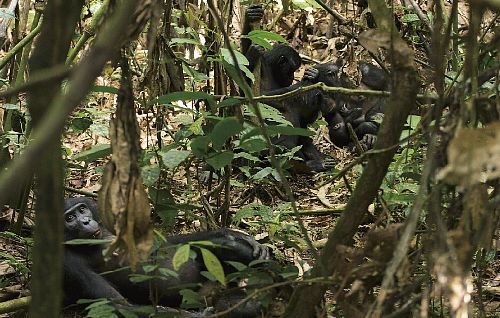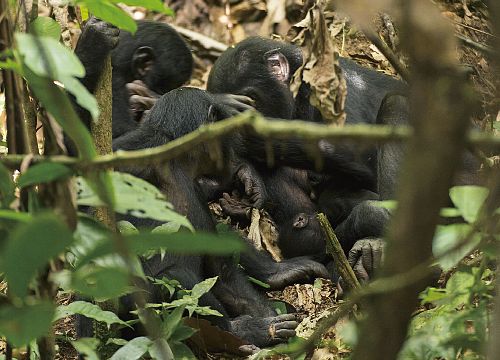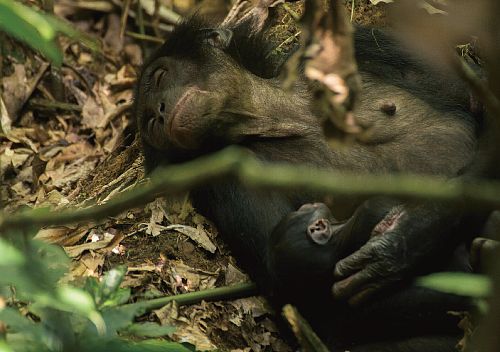|
<NOTE>
A Female Bonobo Sleeping on the Ground after Daytime Birth and its Implications
Heungjin Ryu1,2,3
1 Primate Research Institute, Kyoto University, Japan 2 Research Institute of Eco-science, Ewha Womans University, Republic of Korea 3 National Institute of Ecology, Republic of Korea INTRODUCTION Reduction of predation risk is thought to be one of the main benefits that animals derive from living in a group (Alexander 1974) and a major driving force in the evolution of group-living in primates (Hill & Lee 1998). For bonobos and chimpanzees, the combined effects of large body size and group living may mean that predation risk is relatively low compared with many other primate species, but some reports have suggested that lions and leopards can have a heavy impact on them (Boesch 1991; Tsukahara 1993; D’Amour et al. 2006). Among chimpanzees there is an additional risk from conspecific killing, which is probably responsible for deaths of more infants and adults than predation itself (Williams et al. 2008). Although they are closely related, bonobos are quite different from chimpanzees in terms of conspecific aggression and female–female relationships (Furuichi 2011). Neither direct evidence of infanticide nor conspecific killing has been observed in wild bonobos. Female chimpanzees are less tolerant and compete with each other for local resources, probably as a means to increase their reproductive success (Pusey & Schroepfer-Walker 2013). Female bonobos, on the other hand, often engage in affiliative interactions such as grooming and homosexual interactions called genito-genital rubbing (Kuroda 1980; Ryu et al. 2015) and may support each other in response to aggression from males (Tokuyama & Furuichi 2016). Female bonobos keep this high sociality even during one’s parturition (Douglas 2014). This friendly social environment appears to influence many behavioral characteristics of female bonobos. Here I report a case of a prime parous female bonobo giving birth in the daytime at Wamba in the Luo Scientific Reserve, Democratic Republic of the Congo. The subject female, called Otomi (Ot) gave birth on a daybed on April 5th, 2015. After giving birth, Ot came down to the ground and fell asleep while her nearest neighbor Fuku (Fk) was sitting about 2 m from her. I will discuss how tolerant and supportive group characteristics can be related with behavioral characteristics of female bonobos compared with that of female chimpanzees. METHODS AND BACKGROUND E1 group was originally one of the two subunits of E group which had been habituated by 1976 (Furuichi et al. 2012). Since then, E1 group has been studied for over 40 years at Wamba, with a break of 6 years from 1996 to 2002 because of the civil war in DR Congo. When researchers resumed the field study in 2002, all members of E1 had been re-identified and no artificial provisioning has been conducted since that time (Furuichi et al. 2012). I followed E1 group from dawn to dusk (bed to bed) with two field assistants. We recorded all occurrences of rare behaviors, such as aggression and copulation, as well as membership of the party every hour using the 1-hour party method (Hashimoto et al. 2001). Otomi (Ot) was one of two females that immigrated into E1 from an adjacent group in 2008, at which time she was estimated to be 11 years old (Sakamaki et al. 2015). Ot successfully gave birth to her first offspring in January 2011, and it was named Otoko (Ok; ♀). Ok had grown up and become an independent individual by 2015. Ot had a still-birth in March 2014 when Ok was 3 years and 2 months old. Ot became pregnant again 5 months after the still-birth. This time Ot successfully gave birth on April 5, 2015, and this offspring was named Osamu (OS; ♂). Two months prior to Ot’s immigration, another immigrant female Fuku (Fk) joined E1 group. Fk also gave a birth in January 2011, and her offspring was named Fua (Fa; ♀). The relationship between Ot and Fk was stable and strong in 2015 when the observations in this report were made. OBSERVATIONS At 05:31–06:00 h, April 5th, 2015, Ot was found without newborn infant at the bed site. E1 group moved into the secondary forest, where Musanga trees (Musanga cecropioides) are most abundant. At 07:45 h, Ot stayed in a daybed and I could not detect any particular movement nor vocalization (focal sampling). The only other daybed in the same tree was Ok’s, (about 2 m distance). Two more daybeds were around at 7 m from Ot’s bed (individuals in them were not identified). I left the place at 08:05 h when the focal sampling was over. At 08:45–08:50 h, Ot urinated on the daybed, and left. The urine found on the leaves of shrubs below included some drops of blood. Ot was carrying a newborn infant (OS) with umbilical cord (around 5 cm) still attached. Ot moved into a bushy place and lay on the ground. Ok followed Ot. At 08:51–09:22 h, Fk and Fa appeared at the place where Ot and Ok were. Fk stopped about 2 m from Ot. Fa and Ok approached within arm’s reach of Ot to see OS (Figure 1, Video 1 available online at http://mahale.main.jp/PAN/24_2/24(2)_01.html). Ot sometimes shooed them away when they got too close to OS (Figure 2). Fk was watching Ot from about 2 m away and did not get closer. While taking a rest on the ground, Ot fell asleep and tried to open her eyes (Figure 3 and Video 1). I left with the trackers to avoid disturbing them anymore. 


Ot and her two offspring were then absent from the group until April 13, 2015 (8 days). TN (an adult male; over 40 years old) was also missing from 7th to 13th and it may be that TN ranged with Ot and her two offspring. DISCUSSION After giving birth, a bonobo mother might be expected to experience sleepiness, as shown in the current report. However, sleeping on the ground will increase the risk of being attacked by predators or conspecific individuals. Therefore, it is hard to imagine that a female of a solitary primate species could fall asleep on the ground with a newborn infant. This might be also true for a female living in an intolerant social environment, such as that of chimpanzees. Female chimpanzees increase vigilance and self-directed behaviors when there are more members in close proximity (Kutsukake 2003, 2006). Moreover, other conspecifics can seriously harm one’s newborn infant in chimpanzees (Goodall 1977; Nishie & Nakamura 2018). However, if the risk of predation or harmful contact by conspecifics is very low, females might not need to maintain a high level of vigilance while they are with other group members as described in the current report. Female bonobos maintain close social relationships with each other and support one another in agonistic interactions. These close social relationships and agonistic support enable females to maintain high social status as they are able to counter any attempts by males to dominate them (Parish 1996; Tokuyama & Furuichi 2016). The current report is in line with these findings. If a female bonobo with other group members can benefit from their protection from predation and conspecific harassment, the need for maintaining vigilance will be low. Douglas (2014) also suggested that females get benefit of protection and relief from others during the parturition. Therefore, the cohesive grouping pattern and tolerant female–female relationship might be the medium that makes female bonobos relaxed, even at times when they are relatively vulnerable, such as immediately postpartum. The presence of human observers is unlikely to have been a cause of Ot’s post-partum sleeping. Even though bonobos of E1 group are well habituated, when human observers accidently get too close to bonobos (within about 5 m), they usually move away from the human observers. Females are particularly sensitive to accidental approaches by human observers. Therefore, it seems most likely that the presence of Fk and the stable relationship between them facilitated post-partum sleeping by Ot. It is unlikely that Fk had tracked Ot’s movements until she gave birth. However, given that frequent proximity and affiliative interactions between Ot and Fk, Fk was most likely to be the individual whom Ot would encounter for the first time after giving birth. Nishie & Nakamura (2018) suggested that the temporal leaving of females after giving birth functions as “maternity leave” in chimpanzees to avoid the risk of infanticide. In the current study group (E1), females with newborn infants also range for one to two weeks alone, or only with their other offspring, immediately after giving birth. However, after one or two weeks, females usually join a party and range with group members. This is probably because the mother with a newborn infant can find fruiting trees and avoid predation risk more efficiently by ranging with other group members. Together with the fact that no infanticide has ever been reported in bonobos, the temporal leaving of female bonobos after parturition is more likely related with the cost of ranging with other group members rather than the risk of infanticide. The tolerant group characteristics of bonobos might also allow female bonobos to exploit the benefit of group living more than female chimpanzees can do. This highlights the impact that social environment can have on behavioral characteristics of females. Further comparative studies on difference of behavioral characteristics of the two Pan species will not only help us to understand the Pan species, but may also improve our understanding of how social characteristics of various human societies influence well-being and behavioral characteristics of the individuals in them. ACKNOWLEDGEMENTS I thank research assistants at Wamba and the Research Center of Ecology and Forestry for their great contribution at the study site. I also thank Dr. Takeshi Furuichi, Dr. Tetsuya Sakamaki for their support. I also thank Dr. Hitonaru Nishie and Dr. Kazuhiko Hosaka for reviews on the manuscript. Finally, I thank Dr. David A. Hill for comments on the manuscript and English editing. This study was permitted by the Ministry of Scientific and Technological Research of the D.R. Congo (MIN.ESURS/SG-RST/026/2014) and funded by the Japan Society for the Promotion of Science (JSPS) Asia-Africa Science Platform Program (2012–2014 to Furuichi). REFERENCES Alexander RD 1974. The evolution of social behavior. Annu Rev Ecol Syst 5:325–383. https://doi.org/10.1146/annurev.es.05.110174.001545 Boesch C 1991. The effects of leopard predation on grouping patterns in forest chimpanzees. Behaviour 117:220–241. https://doi.org/10.1163/156853991X00544 D’Amour DE, Hohmann G, Fruth B 2006. Evidence of leopard predation on bonobos (Pan paniscus). Folia Primatol 77:212–217. https://doi.org/10.1159/000091230 Douglas PH 2014. Female sociality during the daytime birth of a wild bonobo at Luikotale, Democratic Republic of the Congo. Primates 55:533–542. https://doi.org/10.1007/s10329-014-0436-0 Furuichi T 2011. Female contributions to the peaceful nature of bonobo society. Evol Anthropol 20:131–142. https://doi.org/10.1002/evan.20308 Furuichi T, Idani G, Ihobe H et al. 2012. Long-term studies on wild bonobos at Wamba, Luo scientific reserve, D. R. Congo: Towards the understanding of female life history in a male-philopatric species. In: Long-Term Field Studies of Primates. Kappeler PM, Watts DP (eds), Springer Berlin Heidelberg, Berlin, Heidelberg, pp. 413–433 Goodall J 1977. Infant killing and cannibalism in free-living chimpanzees. Folia Primatol 28:259–282. https://doi.org/10.1159/000155817 Hashimoto C, Furuichi T, Tashiro Y 2001. What factors affect the size of chimpanzee parties in the Kalinzu Forest, Uganda?: Examination of fruit abundance and number of estrous females. Int J Primatol 22:947–959. https://doi.org/10.1023/A:1012061504420 Hill RA, Lee PC 1998. Predation risk as an influence on group size in cercopithecoid primates: Implications for social structure. J Zool 245:447–456. https://doi.org/10.1111/j.1469-7998.1998.tb00119.x Kuroda S 1980. Social behavior of the pygmy chimpanzees. Primates 21:181–197. https://doi.org/10.1007/bf02374032 Kutsukake N 2003. Assessing relationship quality and social anxiety among wild chimpanzees using self-directed behaviour. Behaviour 140:1153–1171. https://doi.org/10.1163/156853903322589687 Kutsukake N 2006. The context and quality of social relationships affect vigilance behaviour in wild chimpanzees. Ethology 112:581–591. https://doi.org/10.1111/j.1439-0310.2006.01200.x Nishie H, Nakamura M 2018. A newborn infant chimpanzee snatched and cannibalized immediately after birth: Implications for “maternity leave” in wild chimpanzee. Am J Phys Anthropol 165:194–199. https://doi.org/10.1002/ajpa.23327 Parish AR 1996. Female relationships in bonobos (Pan paniscus): Evidence for bonding, cooperation, and female dominance in a male-philopatric species. Hum Nat 7:61–96. https://doi.org/10.1007/BF02733490 Pusey AE, Schroepfer-Walker K 2013. Female competition in chimpanzees. Phil Trans R Soc B 368:20130077. https://doi.org/10.1098/rstb.2013.0077 Ryu H, Hill DA, Furuichi T 2015. Prolonged maximal sexual swelling in wild bonobos facilitates affiliative interactions between females. Behaviour 152:285–311. https://doi.org/10.1163/1568539X-00003212 Sakamaki T, Behncke I, Laporte M et al. 2015. Intergroup transfer of females and social relationships between immigrants and residents in bonobo (Pan paniscus) societies. In: Dispersing Primate Females: Life History and Social Strategies in Male-Philopatric Species. Furuich T, Yamagiwa J, Aureli F (eds), Springer Japan, Tokyo, Japan, pp. 127–164 Tokuyama N, Furuichi T 2016. Do friends help each other?: Patterns of female coalition formation in wild bonobos at Wamba. Anim Behav 119:27–35. https://doi.org/10.1016/j.anbehav.2016.06.021 Tsukahara T 1993. Lions eat chimpanzees: The first evidence of predation by lions on wild chimpanzees. Am J Primatol 29:1–11. https://doi.org/10.1002/ajp.1350290102 Williams JM, Lonsdorf EV, Wilson ML et al. 2008. Causes of death in the Kasekela chimpanzees of Gombe National Park, Tanzania. Am J Primatol 70:766–777. https://doi.org/10.1002/ajp.20573 Back to Contents |